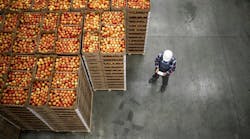Plants that handle organic foods and beverages must be kept clean and free of pests, just like every other food plant. But in some respects, they have fewer options on just how to do that.
To reach and maintain organic status, a plant has to keep product from coming in contact with unapproved substances. That includes some chemicals widely used for cleaning, sanitizing and pest control. Keeping a plant on the right side of organic regulations means choosing compatible chemicals – or even eschewing them altogether.
Federal regulations specify that chemicals to be used in an organic plant be approved by the National Organic Program (NOP), which is administered by USDA. The NOP maintains a list of chemicals approved for such applications.
“There are only a select number of sanitizers that are certified for use with organic product and allowed by the National Organic Program,” says Neal Mays, manager of strategic accounts for produce and safe foods at PSSI, a contract sanitation company.
That leads to a somewhat narrow range of choices for cleaning and sanitizing chemicals.
“The kinds of cleaning/sanitizing chemicals that are indicated for an organic plant include sanitizers that are primarily chlorine—or peracetic acid/peroxyacetic acid-based,” says Rick Stokes, area technical support manager for food safety at Ecolab. “The chlorine materials are used for disinfecting and sanitizing food contact surfaces whereas the peracetic/peroxyacetic acid is used for wash or rinse water, or as a sanitizer for food contact surfaces. Phosphoric acid is used for acid cleaning, and sodium hydroxide is used for caustic cleaning.”
Swabs of processing surfaces, a standard procedure in any plant, take on added significance in an organic one. Photo: PSSI
The choice of cleaning and sanitizing chemicals is determined by how they’ll be applied. The two terms are often used interchangeably, but strictly speaking, cleaning refers to the removal of dirt, residue or other extraneous material from a surface; sanitizing means applying a biocide like bleach or acid to a clean surface to keep it free of microorganisms like bacteria.
In general, there is a wide leeway for which cleaning chemicals can be used in organic plants, because cleaning chemicals are almost invariably rinsed off. That is not, however, always the case with sanitizers.
“Chemistry made from materials not on the NOP national List are not allowed to come in direct contact with organic food, so these can only be used if there is an effective means to prevent the [chemicals] from coming into contact with organic food,” Stokes says. Rinsing them away before food contact is allowed would be one means.
To rinse or not?
The FDA’s document on organic cleaners and sanitizers explicitly states that “the cleaning agent itself is not required to be organic” and that “unlike sanitizers...cleaners and detergents are designed to be rinsed off, and a subsequent rinse step is sufficient to prevent contamination of organic foods from synthetic cleaner residues.”
Sanitizers are another story. “Some commonly used sanitizers in food production are considered prohibited,” says Shannon Murphy, a consultant with The Organic Consulting Firm, a certification agency for organic status. “An operation may still use the material but there must be an intervening step between the use of the material and organic production.”
That intervening step is rinsing. If sanitizers are to be used in an organic plant, they fall into two basic categories under FDA regulations: those that must be rinsed off, and those that don’t need to be.
Both kinds include commonly used varieties of sanitizers. In the no-rinse category are peracetic/peroxyacetic acid, chlorine (in proper concentration), hydrogen peroxide, phosphoric acid and other substances. In the must-rinse category go acetic acid, ethyl or isopropyl alcohol, quaternary ammonia, vinegar, citric products and more.
“An operation may choose to use quat [quaternary ammonia], but prior to organic production will need to rinse the equipment to remove any remaining quat from the food contact surfaces,” Murphy says.
It’s a consequential decision. Using a sanitizer that has to be rinsed off increases both labor and water use. In addition, most sanitizers are intended not to be rinsed off; the point is that they leave traces behind that combat microbial contamination on an ongoing basis. Rinsing them off can compromise their effectiveness in this regard.
Pesky pest control
Pest control is an ongoing concern in keeping plants clean. The problem can be especially acute for certain kinds of organic ingredients, because they can’t be treated with pesticides and so are especially liable to infestation.
The approach to pest control is generally the same for an organic plant as for any other: use of non-chemical means first, like traps, improved sanitation and removal of situations or areas where pests can accumulate. If those don’t do the trick, then it’s time to resort to chemicals.
“For those facilities following organic rules, there is an order in which control tools are used,” says Patricia Hottel, technical director at McCloud Services. “This will be different and more restrictive in regard to pesticides. Following the prescribed hierarchy or order in which control tools are deployed, will help drive some of the non-chemical control techniques such as improved sanitation, pest exclusion and traps.”
When chemicals are required for pest control in organic plants, it usually must be done with chemicals from an approved list. Photo: McCloud Services
If chemicals are used, it’s a similar situation to cleaners and sanitizers: They have to come from an approved list. In this case, it’s the USDA’s National List of Allowed and Prohibited Substances.
“Materials appearing on the list are primarily naturally occurring materials,” Hottel says. “Examples of some of the materials that appear on that list include the rodenticide vitamin D3 and the insecticide boric acid.” Other pest-control chemicals compliant with organic standards include diatomaceous earth and pheromone traps, both used to control insects.
In extreme circumstances, when facing very bad instances of pest contamination, organic plants can be permitted to use chemicals that are not on the National Organic Program list. But this needs to be coordinated with the third party that’s certifying the plant as organic, and can only be done according to strict guidelines.
“Should NOP-approved chemicals be insufficient to control pests, non NOP chemicals can be approved by the organic agent,” says Mitchael Jashinske, senior technical and regulatory specialist for PSSI Pest Solutions. “This process includes a summary of actions, recommendations and corrective actions to be completed prior to approval as well as an explanation of measures that permission is being sought, with explanation of specific substance and method of application. Also, included is an explanation of how unprotected food sources and food contact surfaces will be protected from potential contamination.”
The basic difference is that an organic plant can’t be as quick as a conventional one to rely on chemicals for pest control, Murphy says: “Where a non-organic company can move directly to the synthetic pest control materials, an organic company is required to try other methods before moving to the synthetic materials.”
Like many other aspects of running an organic plant, cleanliness and pest control are more of a challenge than they are in conventional ones. Going into those challenges with open eyes confers a greater chance of overcoming them.


